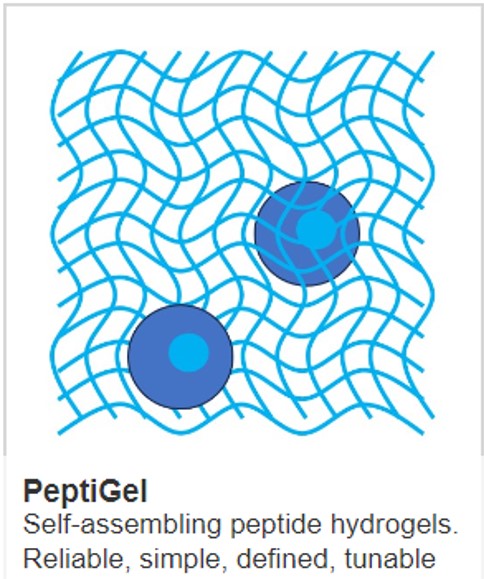The Advantages of Peptide Hydrogels in 3D Cell Culture

Most research still focuses on 2D cell cultures where cells are grown in a flat monolayer on a plate. However, 3D cell culture provides a culture environment that allows cells to grow and interact with the surrounding extracellular matrix in three dimensions. Peptide hydrogels are an ideal matrix choice for 3D cell culture.
3D Cell Culture Scaffold
3D cells are usually cultured within a supporting scaffold that allows growth in all directions. The most popular types of extracellular matrix scaffolds include:
- Hydrogel Matrices – Produced using polymeric material containing a network of polymer chains that are crosslinked and that can absorb and retain water. Hydrogels can be derived from animals or plants, synthesized from chemicals or be decellularized tumour extracellular matrices.
- Inert Matrices – Produced from sponge-like membranes of polystyrene which contain pores for cells to grow and proliferate.
Why Do We Use 3D Cell Culture?
Scientists studying cellular and disease mechanisms have relied on flat 2D cell cultures for a long time as they are simple to use and cost-effective. However, 3D cell cultures have grown in popularity in the last ten to twenty years thanks to the fact that they are more physiologically relevant and better represent in vivo tissue.
No cell types within the human body grow as a monolayer that is independent of other cells or tissues. They tend to grow in 3D structures that are complex and contain different cell types within an extracellular matrix. The numerous cell-matrix and cell-cell interactions that take place in this structure all have an effect on cell behaviour.
In addition to this, 2D monolayers have uniform access to oxygen and nutrients, which again is not the same as 3D cell masses, such as cancer tumours. 3D tumour spheroids are more representative of in vivo tumours, with inner cells having less access to oxygen and nutrients in comparison to the outer layer.
Applications of 3D Cell Culture
3D cell culture models are increasingly being used to better understand disease mechanisms as well as to discover drug therapeutics. 3D cell cultures can be manipulated to allow scientists to understand disease pathways better or screen for small molecule drugs. This is because 3D cell cultures tend to more accurately predict the toxicity or efficacy of drug treatment, as compared to 2D cultures.
3D Cell Culture Assays
One of the main challenges facing scientists who are working with 3D cell culture assays is finding the assays that will work with a specific cell type. Most existing cell-based assays were originally designed for 2D monolayers or cells in suspension, and so their design does not take into account the mass or size of 3D structures. This can mean that cell lysis is limited, or assay chemistry is overwhelmed.
Advantages of PeptiGel hydrogels
So, what advantages do PeptiGels® hold over other 3D cell culture matrices? In fact, there are many. These include:
- Peptide hydrogels are animal-free and fully synthetic allowing customers to obtain more reproducible and reliable results when compared to natural and animal-derived scaffolds
- Peptide hydrogels give the benefits of both natural and synthetic scaffolds because peptides can be synthetic materials but are exactly the same as the natural building blocks of life
- Their mechanical properties of PeptiGels can be altered to mimic all human tissues and create a more representative in vivo model in vitro.
- PeptiGels temperature stable and can be used at room temperature
- PeptiGels are biocompatible and are being translated toward the clinic
IMAGE: Peptide hydrogel. Credit: Manchester biogel
Learn more about powerful technologies that are enabling research:



